A shorter version of this post appeared on the website of The American Scholar in August, 2021, as “A Tall Order.”
“Do you want to go down there and get a better picture?” I asked from behind the wheel.
“Yes,” said Virginia from the passenger seat.
We turned off Montana Route 228 onto a gravel road and drove a few hundred yards to get a better look at a wooden grain elevator rising flèche-like from a sere plain. Its top was narrower than its body and had a single square window, like a window in a cupola.
Most of the building’s skin was made of narrow horizontally laid boards painted white, with half the paint gone. The bottom fifth, however, was barn red and brought to mind the color discontinuity in the Washington Monument that occurred when construction was stopped and resumed with different-colored stone 23 years later.
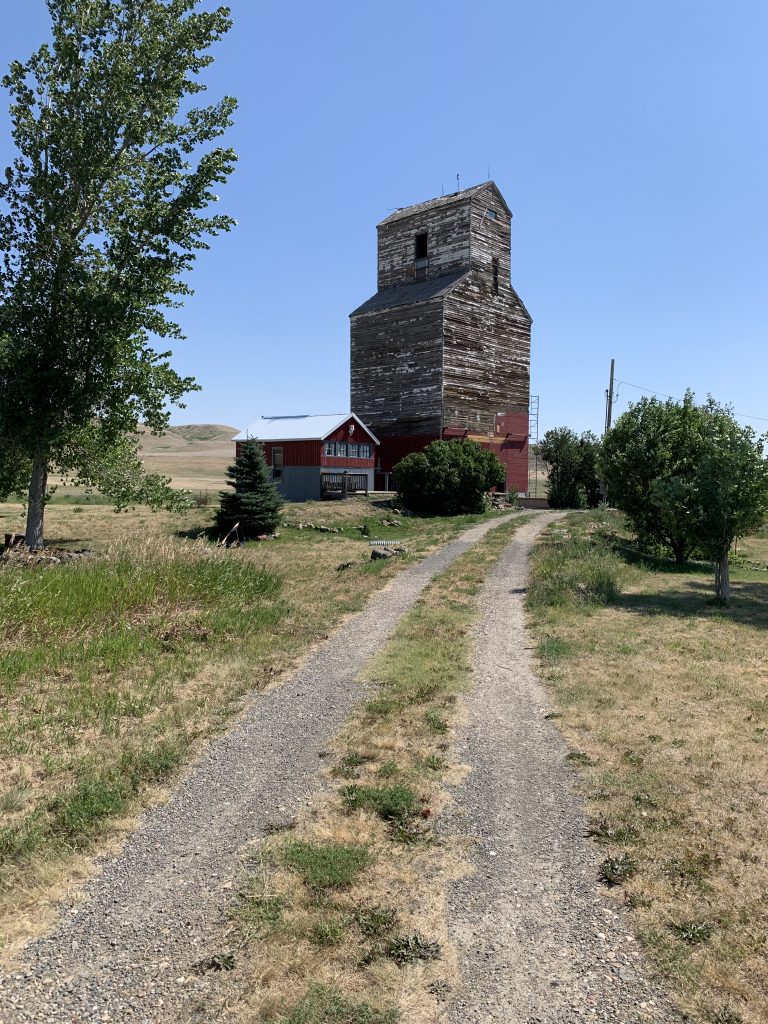
As I drove toward the elevator and prepared to park a respectable distance away I saw a man disappear around the corner of the building. Virginia and I got out, took a few iPhone pictures. As I walked toward the building, the man reappeared.
“May we take a few pictures of your wonderful building?” I asked. He said we could. His assent began a two-hour encounter too good not to record.
The day before, Virginia and I had come off a four-night trip through the lower Missouri Breaks. Now, we were heading to the Little Big Horn battlefield, with an overnight first in Billings. We were taking non-interstate roads and stopping at any historical marker, visual attraction, or weirdly named burg that caught our eyes. Later that day, we visited Two Dot, a town so nearly abandoned it should be renamed One Dot, or possibly Dotless.
The wooden grain elevator, near Highwood, Montana, was our first detour.
The man who greeted us is named Michael Benzinger. He’s a 66-year-old, mostly retired house painter who’s restoring the elevator as a home for himself and his wife (who’s younger than he, and still working as a house painter). They hope to make a rentable guest apartment in the elevator too; there’s plenty of room.
Mike bought the grain elevator in 2001 for $1. It came with one acre of ground. It’s part of a settlement of a half-dozen houses that’s now occupied by one other person, an 87-year-old man. The place is called Big Sag, which is a reference to its geological history as a former bottom of the Missouri River.
Mike learned of the grain elevator from someone whose house he was painting in Fort Benton. That person was willing to let it go if Mike was willing to try to save it. “They’re burning roughly one of these a day in the West,” Mike said. He later added that was mostly happening in Canada.
With a beaked nose and a mouth that turns down at the corners, Mike bears a considerable resemblance to George W. Bush. He has a brush cut. He was tanned, but not overly so, and wore a white tee shirt with a logo from the California burger chain In-N-Out. He gave off none of the exhaustion or second thoughts one might expect from a person who’s single-handedly repurposing an 70-foot industrial building that had been abandoned for 30 years when it became his.
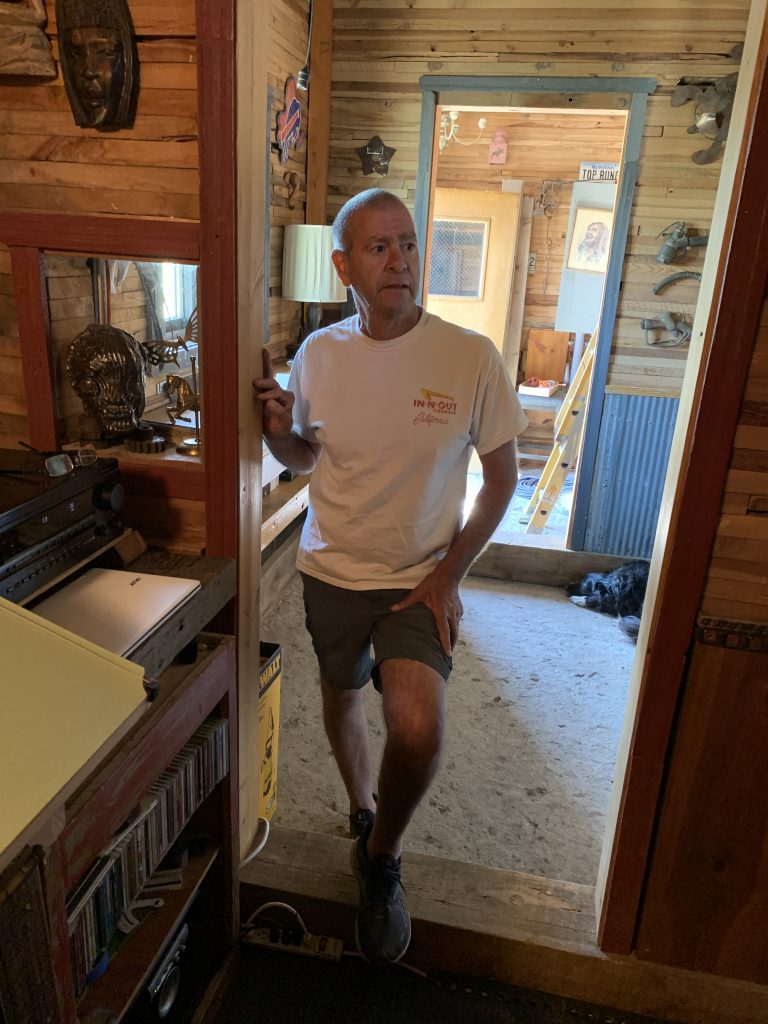
He’s not certain when the elevator was built, but guesses it was 1911, the date stamped on the lightning rods on the roof. He’s found grain receipts from 1912, so it was in business at least by then.
Mike and his wife have lived in a building next to the grain elevator for three years. It’s 400 square feet and used to be the power plant of the operation. “It’s one open room–and not a lot of room for two people, two dogs, and two cats,” he said without complaint. I asked if it had a wood stove. “No,” he said. “One spark and the whole thing could burn up.” He nodded next door as we stood on the stone deck around the tiny building. You could tell the grain elevator was already a pillar of sweat and blood, almost a child, he’d protect any way he could. They heat the house with electricity.
He took us into the main room on the ground level, which was the full depth of the building. He’d put in three cathedral windows on the far wall; they looked up the brown grass slope to the road from which we’d seen the building. On the left-hand interior wall was a basketball hoop, on the right shelves with objects he’d found in the elevator or gleaned from trips to the dump.
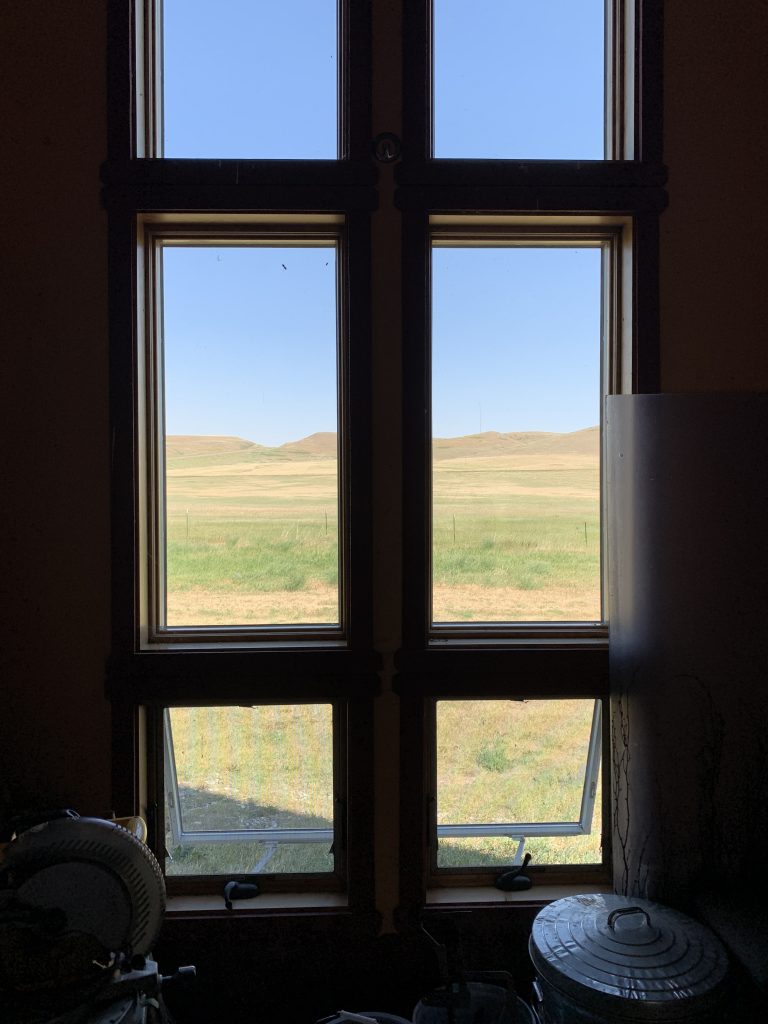
Notable among the latter was a collection of oil cans, reminiscent of (and larger than) a dozen I bought at an auction in Philadelphia in the 1980s. I find old oil cans mysterious and poignant. They’re often all that remains of machines they once kept running. Many are stamped with the names of companies that themselves no longer exist.
Left over from the elevator’s active days of was a sign proclaiming that it wouldn’t accept “treated grain”–referring to it as “poison”–and a set of New York-made weights for weighing samples. The most beautiful objects were paddles with single oval holes in them. Inserted into chutes, they were used to control the flow of grain.
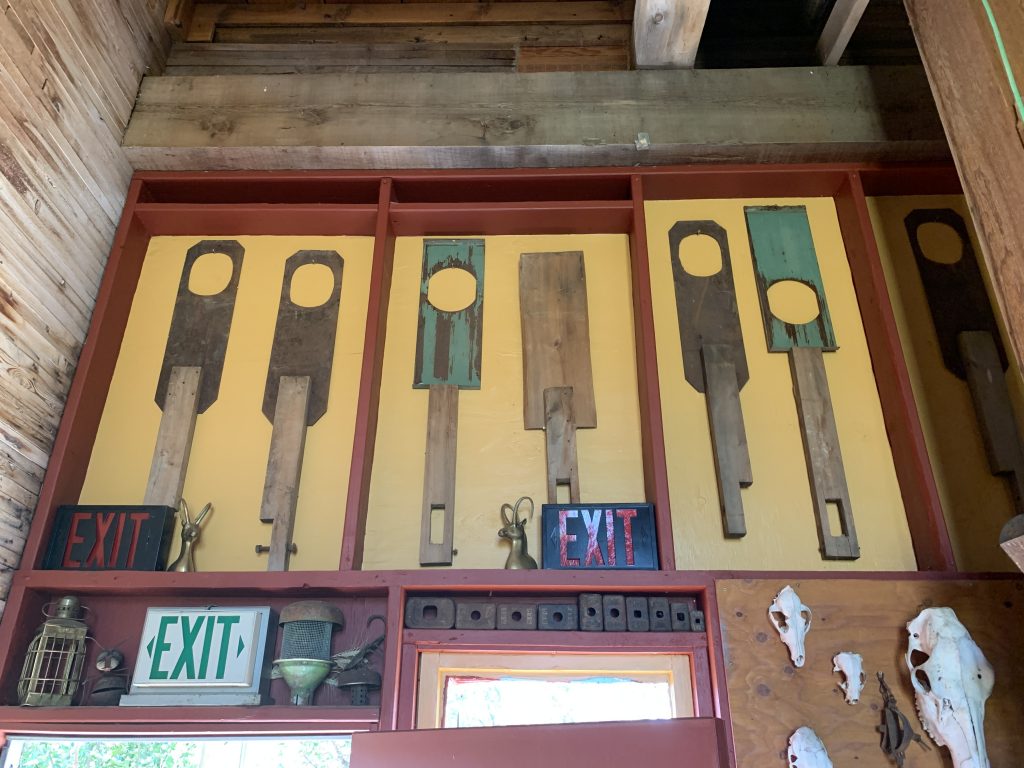
Mike said the building was in surprisingly good shape despite its long vacancy when he took possession of it. Only the top had let in birds (he mentioned flickers) and needed serious repair. The structure had survived because of skilled construction from massive lumber that arid climate and grain dust had dried into the equivalent of petrified wood.
Inside, it appeared as if the walls had been refinished, but all he’d done was power wash them, rappelling from the top through each bin. The only visible wear to the wood was in a few places where gravity-fed grain had inadvertently come into contact with a wall for years, sculpting patterns of flow the way water does to rock. The interior is Douglas fir, the exterior siding is cedar.

The most interesting thing in the main room was a feature still in use–a “man lift” that allows a person to ascend to the top of the elevator. Mike had replaced the cables and refurbished the brake, but it was otherwise little changed.
It consisted of a small, unenclosed platform with cable that went up the to the top floor of the elevator, through a pulley or shackle of some sort and then back down to a counterweight. Without a passenger the platform is at equilibrium. When a person stands on it and pulls a rope that also goes to the top, the platform rises with little effort. Stop pulling, and it slowly descends. It can be stopped anywhere by holding the rope, and can be locked in place for work with a brake.
Mike demonstrated it and then graciously allowed Virginia and me to take beginner spins, up about 20 feet. Neither of us was seriously tempted to take it to the top. The alternative route is on a vertical ladder built into the corner of the main shaft, which is scarier.
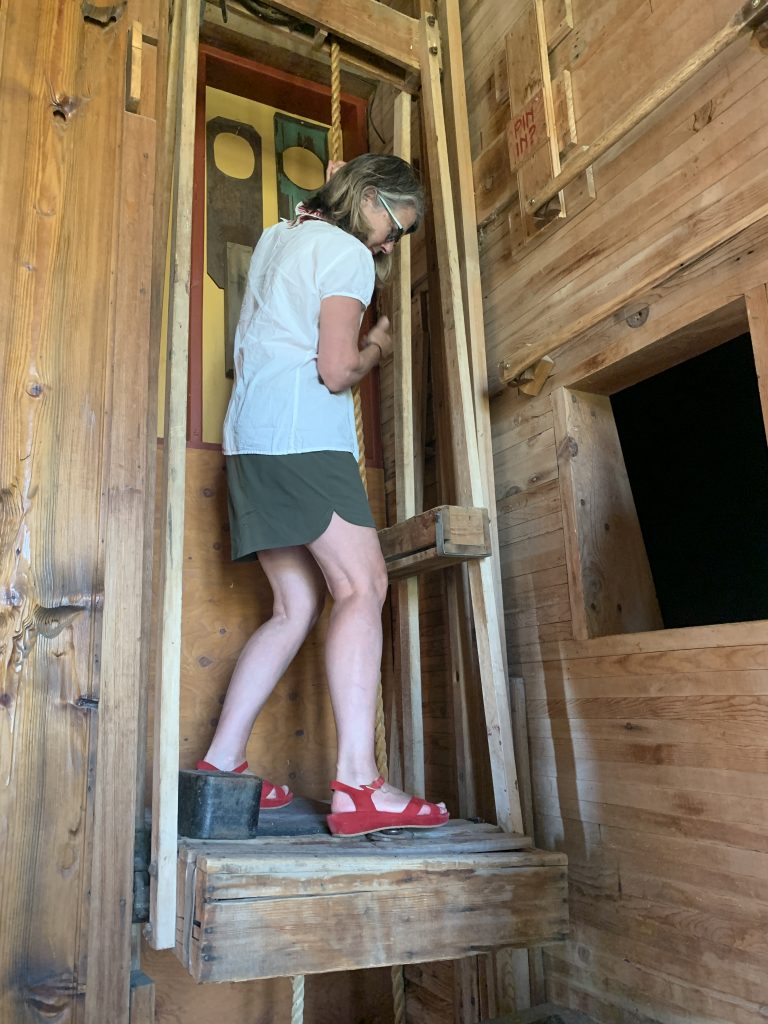
Most of the interior space of the building is divided into bins about 10-feet square. Mike is turning those on the two levels above the ground floor into living space, and invited us upstairs to have a look. As we ascended the railless staircase, the treads squeaked. He told us he’d put the squeaks in intentionally.
“Let’s you know if someone’s coming,” he said with a smile.
He’s removed the walls between some bins to make large rooms, but keeping others intact. He likes the intimacy of the spaces, and the fact they telegraph the building’s original use. He showed us the library, and a meditation room for his wife.
“The biggest part of the job was taking out the floors,” he said. Why take out the floors? we wondered. Because they all sloped–intentionally, to facilitate the flow of grain in and out of them. Some bins had three layers of floor, each on a slant.
Of course, the interior isn’t the only part that needs work. Many boards in the exterior siding need replacing. Mike plans to put a new skin on much of the building–tar paper over the wood, and galvanized tin over the tar paper. It will then look a little more like its modern descendants everywhere on view in Montana’s wheat country. On the east side of the building he’s already finished about 30 feet up.
“I got the metal from a farmer on that first farm up on the bench,” he said, gesturing out a window. “I helped him harvest one season. He said I could have it for free, but I wanted to give him something. Plus, I got to learn how to drive a combine, which is trickier than you’d think.” I commented on the amount of scaffolding he has up, and how much, much more he’ll need.
Even when the carpentry is finished there will be more work to do. Plumbing will be a big job. At the moment, Mike and his wife get water from a spring on a rise in the land behind the settlement. It’s delivered by gravity through a hose, and they carry buckets of it into the house. There’s no running water inside and they use an outhouse next to the elevator. On the deck was a black rubber bathtub full of water, warming in the sun. “That’s where we bathe,” he said. I didn’t ask about winter.
It’s a hard life, and sometimes a dangerous one.
A year or so ago, Mike’s wife was bitten by a rattlesnake. She was flown to a hospital in Great Falls. Physicians initially thought the strike had been dry, and hadn’t given her anti-venom. The next day, however, her leg began to swell so much she had to have a fasciotomy to relieve the pressure.
It turns out an underground delivery bin for grain near the elevator’s front door was a cool and damp home for snakes. It took five dumptrucks’ worth of gravel to fill it.
It’s also a lonely life. Mike works alone most of the time, his wife away during the day earning a living. His dogs, a border collie named Smokey Bear and a border collie mix named Arrow, follow him room to room. Two days before we met him, however, he finally got an internet connection. Next task: an e-mail address.
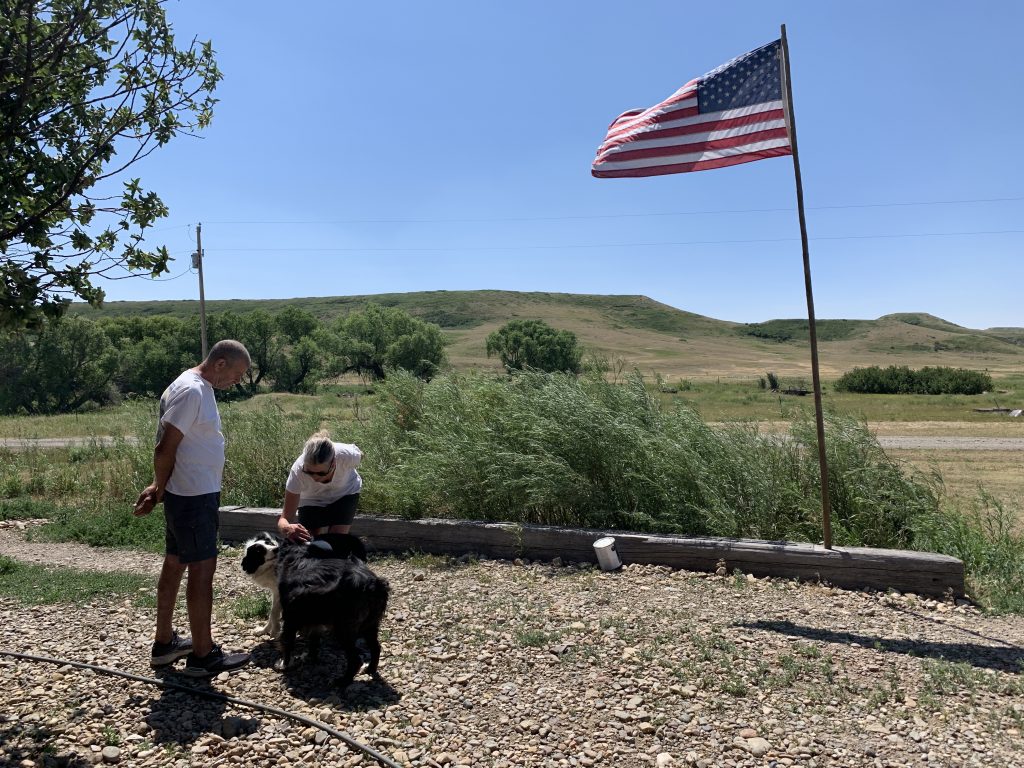
So, he’s happy to have visitors. “I’m kind of proud of it,” he said as we played with the dogs a final time before leaving. “If it inspires someone, I’m happy. It shows what’s possible, even if you’re working by yourself.”
That’s not the only lesson.
Keep the travel plans to a minimum. Turn off the road. When in doubt, stop and look around. There’s always something interesting over the next rise.
At least in Montana.
Recent Comments